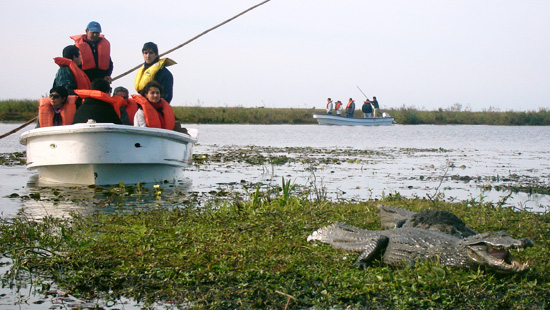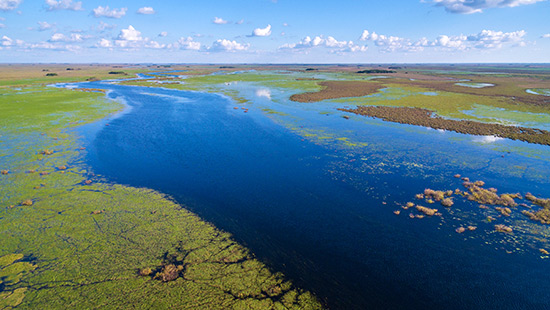| |
|
Future Iberá National Park
Why Promote the Creation of National Parks?
In 1903 Argentina created the National Park public body in order to preserve its best natural areas and scenic beauty while at the same time making it accessible to the public. National parks in Argentina as well as in many other countries, hold to the most important wilderness areas around the world. They are true natural wonders looked after and managed for the benefit of present and future generations.
The possibility of creating the largest park in Argentina within the Iberá Provincial Reserve is currently being considering by CLT. This national park would consist of 553,000 hectares that are already owned by the state of Corrientes along with another 150,000 that would be donated by The Conservation Land Trust (CLT) foundation. Since it would consist only of public lands and lands belonging to a conservation organization, its creation will not affect property rights or ownership of neighboring private farms. Beyond the CLT willingness to donate land for this purpose, the final decision will depend on the authorities of Corrientes and Argentina.
Reasons why CLT thinks Corrientes should have the largest park in the country. Click on each item to read the explanation:
- Iberá is one of the largest wildlife reserves in the country
-
Iberá’s wetlands, grasslands and forests harbor more than 4,000 species of flora and fauna, representing about 30% of the wild species of Argentina. The future Iberá National Park would house the second largest population of marsh deer in the world. It will serve as an essential refuge for threatened species such as the maned wolf, the pampas deer, several grassland birds that are virtually extinct in Argentina, caiman and river otters, amongst others. Also, due to its size and habitat quality, this conservation area represents a unique opportunity to reintroduce locally extinct species like the anteater, the tapir, the collared peccary, the pampas deer, the ocelote, the giant otter and the jaguar. Its vast biological diversity, coupled with its tamed fauna, makes Iberá the best place in Argentina for sighting wildlife. We think that this great natural treasure deserves the highest level of protection possible in order for it to be enjoyed by present and future generations of the people of Corrientes and Argentina.
- National parks represent one of the best of Argentine traditions
-
Few people know that Argentina was the third country in the world to create a national park, ahead of any European country. This noble tradition was inaugurated in 1903 by Dr. Francisco P. Moreno, who donated three square miles (7,000 hectares) in Argentine Patagonia to "maintain its natural physiognomy where only works that provide comfort for visitors are allowed to be carried out", thus laying the foundations of the current Nahuel Huapi National Park. More recently, in Corrientes and only a few kilometers from Iberá, Danish citizen Troels M. Pedersen donated his 17,660 hectare property to establish Mburucuyá National Park in 2001. Currently the country has 36 national parks that are kept and managed by the National Parks Administration, an institution with over 70 years experience in the management and conservation of nature.
- National parks represent the most significant tourist destinations
-
In any country in the world, national parks offer environmental and scenic quality that drive tourists into choosing to visit them over any other type of landscape or nature reserve. In Argentina, three of the four most visited tourist destinations -the Iguazu Falls, the Nahuel Huapi lake with its surrounding forests and Andean mountains and the Perito Moreno glacier- are within national parks. The National Parks Administration have historically promoted ecotourism development of these destinations, with the construction of very good architectural quality infrastructure, adequate interpretive trails for proper handling of visitors and professional care for the natural environment.
- National parks serve as a guarantee of conservation and long-term care
-
In Argentina, as in any other country in the world, the National Park status means the maximum public commitment to the care of nature. Federal forums and the Supreme Court intervene when the natural resources within a national park have been harmed or damaged, making it very difficult for business pressures, influential people or people with particular interests to violate the rules since sentences and fines are applied with the greatest rigor.
National parks protect not only everything that is on the ground, but also the subsoil and air (preventing mineral exploration, and commercial overflights at low altitude). Provincial Parks and Reserves do not have the same power to face or counteract the weight of mining and oil laws.
Because of the National Park’s autarchic quality and its political board of 5 members which have been selected by different ministries it is more likely to interact with the administrative structure of the executive branch, facilitating the implementation of protected areas management plans. Additionally it holds a technical team of professionals selected through public tender and a park ranger unit which has been trained by the National Parks system through a school especially established for that purpose. As a consequence, there has not been a case in Argentina of attempted disaffection of a national park by the national or provincial authorities. On the other hand, there are numerous precedents of provincial natural reserves which have suffered a reduction either in their extension or in their protection explicitly enabled by the governments of the provinces.
- National parks are guarded by all Argentines
-
In Argentina there are 528 protected areas of different categories, but only 36 have had the merit to be declared a national park. Despite the growing interest in ecology and environmental issues, very few people know and can closely follow what goes on in each of the existing provincial reserves. There are daily calls alerting to defend and save these natural areas from new threats, and the list of concerns and urgent needs increases with the environmental crisis. National parks are areas recognized as a priority by all Argentines, therefore a greater response from the public to imminent risks can be seen, thus avoiding the possibility of urgent problems of the country to overshadow the calls for help for these areas.
- A national park will not entail any cost to the people of Corrientes, at the same time it provides them with every benefit
-
Creating the future Iberá National Park will imply no cost to the people of Corrientes, since CLT would donate their land for free and the National Park Administration will manage the Park with funds provided by the Nation. Being an autonomous body with its own budget, National Parks are in no danger of their budget being cut or reallocated to cover the needs of other administrative structures in the event of a financial crisis. At the same time all the environmental care and tourism benefits associated with the park would be gained by the locals. Private landowners whose lands border the park would see an increase in the value of their land, as has happened to other national parks such as Nahuel Huapi, Iguazú and the Glaciers.
What is the Future Iberá National Park?
Iberá National Park is the vision of CLT directed at creating an area that conserves in perpetuity the natural ecosystems of Iberá, maintaining their full diversity and ecological integrity while serving as a great area for regional development through ecotourism.

Currently, of the 1,300,000 hectares that constitute the Iberá basin and Natural Reserve, 482,000 make up the Iberá Provincial Park. In order to ensure the ecological integrity of the Iberá basin and the highest quality of it as an eco-tourism destination it is crucial that the Park also includes representative samples of the upland ecosystems found in it. To the same extent, if we want Iberá to harbour all large mammal species that have become extinct in the region, we need the ecosystems that they inhabit to be properly protected.
To achieve this CLT has acquired 150,000 hectares of old cattle ranches that border with the public lands and which include habitats that are not present in the current Iberá Provincial Park such as the espinal savannas, the malezal or flooded grasslands or forests, in order to ensure that these are included within the strict conservation area, creating an area of nearly 700,000 hectares that will constitute the future Iberá National Park.

Within its limits this great park will shelter the largest population in the world of the threatened strange-tailed tyrant and the second largest of the marsh deer; also serving as a critical refuge for endangered species such as the maned wolf, the pampas deer, grassland birds that are virtually extinct in Argentina due to agricultural activities, caimans and the river otter, amongst others. Additionally, because of its size and high quality habitat, this conservation area represents a unique opportunity to attempt the reintroduction of locally extinct fauna such as the giant anteater, the tapir, the collared peccary, the pampas deer, the ocelot, the giant otter and the jaguar.
Iberá National and Provincial Park would in turn be surrounded by more than 600,000 hectares of private lands included currently in the Iberá Natural Reserve, which could potentially be destined to different types of sustainable production while benefitting from the touristic attraction of the strict conservation central area.
|
|
|

